The Economics and Statistics Division maintains archives of previous publications for accountability purposes, but makes no updates to keep these documents current with the latest data revisions from Statistics Canada. As a result, information in older documents may not be accurate. Please exercise caution when referring to older documents. For the latest information and historical data, please contact the individual listed to the right.
<--- Return to Archive
For additional information relating to this article, please contact:
April 08, 2020HOUSING STARTS, MARCH 2020 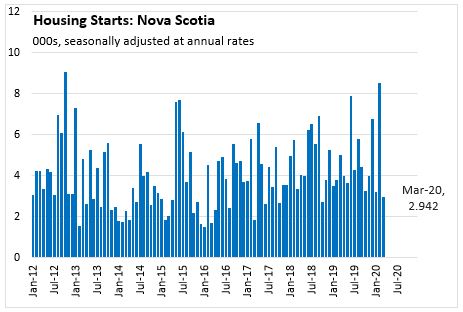
Nova Scotia's housing starts (seasonally adjusted annualized rate) decreased by 65.5 per cent rom 8,520 in February to 2,942 in March. Compared to March 2019, Nova Scotia housing starts were lower by 41.3 per cent.
Housing starts were down 77.6 per cent in Halifax from 5,816 in February to 1,302 in March. Halifax starts were lower by 70.3 per cent compared to March 2019.
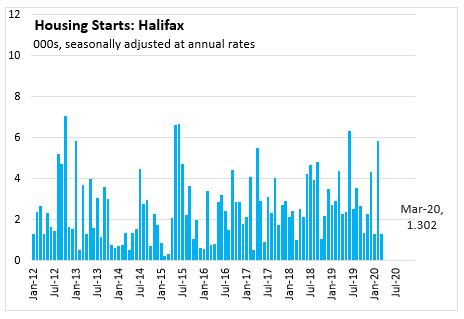
Outside Halifax, Nova Scotia's housing starts were lower 39.3 per cent from 2,704 in February to 1,640 in March. Compared to March 2019, housing starts outside Halifax were up 161.6 per cent.
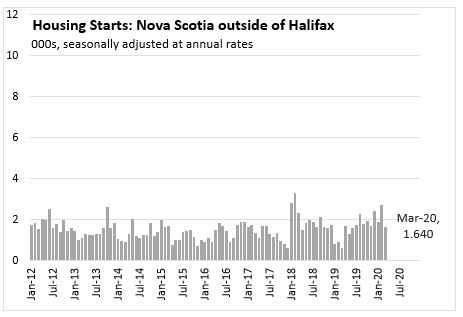
The six-month moving average of housing starts in Nova Scotia and Halifax show similar trends. There were increases in starts, particularly among multiple unit dwellings in the summer of 2018 and the summer of 2019. These starts then faded towards the end of the year. The trends outside Halifax are different, with a rise in starts in the first half of 2018 followed by a decline over the next year. Since then, housing starts outside Halifax have been rising.
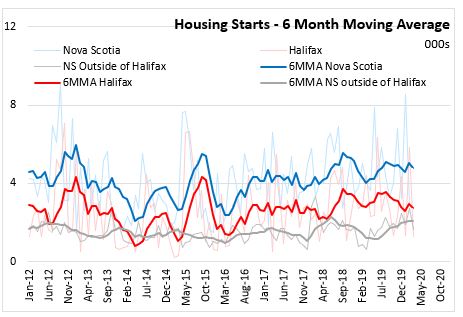
In urban areas, housing starts for multiples are generally higher than for singles with greater variability month-to-month. The six-month moving average for singles increased in the summer of 2018 and in the summer of 2019. The pace of multiple starts in urban areas has been more volatile, with peaks in summer of 2018 and summer of 2019.
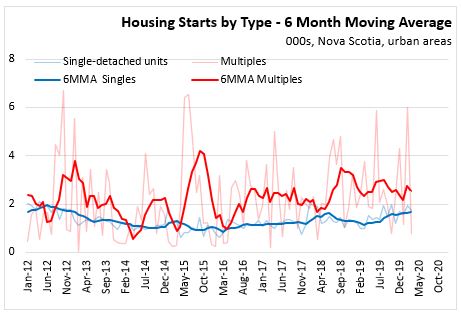
Nationally, housing starts were down 7.3 per cent in March to 195,174 compared to 210,574 in February. National housing starts were 1.2 per cent higher than they were in March 2019.

Compared with the January-March period in 2019, housing starts were up 11.0 per cent across Canada. Eight provinces reported increases, led by Prince Edward Island (82.5 per cent) and New Brunswick (80.0 per cent) Declines were observed in British Columbia (-9.9 per cent) and Manitoba (-2.0 per cent).

Note: Urban areas are defined as areas over 10,000 people
Table 34-10-0158-01 Canada Mortgage and Housing Corporation, housing starts, all areas, Canada and provinces, seasonally adjusted at annual rates, monthly (x 1,000)
Table 34-10-0156-01 Canada Mortgage and Housing Corporation, housing starts in all centres 10,000 and over, Canada, provinces, and census metropolitan areas, seasonally adjusted at annual rates, monthly (x 1,000)
<--- Return to Archive